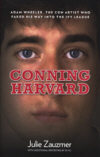Conning Harvard
Adam Wheeler was by all accounts a very successful 21-year-old. He entered his senior year at Harvard University with everything going for him: top marks in his courses, a large circle of friends, and a steady girlfriend, not to mention scads of prestigious academic honors and awards. Indeed, it seemed that there was nothing this affable wonder boy couldn’t do. There was just one problem. All of his success—from the impressive academic grants he received to his very admission to Harvard University—was predicated on fraudulent transcripts, fake SAT scores, phony letters of recommendation, and enough plagiarized prose to fill a library. In short, everything people thought they knew about Adam Wheeler was a lie.
Adam Wheeler was by all accounts a very successful 21-year-old. He entered his senior year at Harvard University with everything going for him: top marks in his courses, a large circle of friends, and a steady girlfriend, not to mention scads of prestigious academic honors and awards. Indeed, it seemed that there was nothing this affable wonder boy couldn’t do. There was just one problem. All of his success—from the impressive academic grants he received to his very admission to Harvard University—was predicated on fraudulent transcripts, fake SAT scores, phony letters of recommendation, and enough plagiarized prose to fill a library. In short, everything people thought they knew about Adam Wheeler was a lie.
While Wheeler’s story might sound like it was ripped from an episode of Gossip Girl, it is in fact a true story. Julie Zauzmer’s book Conning Harvard chronicles Wheeler’s story from his obscure high school days to his very public and very rapid fall from academic grace. Essentially, this is a confidence caper for the academic set. Given the scope and depth of Wheeler’s snow job, it’s not immediately clear which party has more right to be embarrassed. As the book notes: “‘Harvard hoax’—the catchphrase that caught on to describe the case in the blogosphere—briefly became common parlance on the Internet.” It was as if the general public was quite delighted by Mr. Wheeler’s ability to perpetrate a swindle of such magnitude.
Though Wheeler faked nearly every detail about himself, apart from his name, on virtually every document that mattered to Harvard, it is perhaps the fact that he managed to lie so completely and so successfully time and time again that proved the most embarrassing for the ivy institution. Based on his real SAT scores and GPA, he shouldn’t have been able to outwit the admissions officers, his professors, and his friends at Harvard. And yet he did. Therefore, it seems only fitting that one of Harvard’s own should faithfully investigate and record exactly how Adam Wheeler managed to dupe some of the smartest people in the country for so long without detection.
Zauzmer’s account of Wheeler’s dishonesty is unfailingly thorough. A Harvard undergraduate herself and editor for the University’s paper The Harvard Crimson, she began covering the story of Wheeler’s academic disgrace as soon as the sordid news broke. Though her writing does at times read like a senior thesis on how to cheat, Zauzmer nonetheless delivers a no-nonsense account of Wheeler’s every move, dishonest or otherwise. However, her journalistic zeal to find and relay all of the facts is tempered by a dose of empathy as she acknowledges the immense pressure placed on college students these days. Conning Harvard affords readers the opportunity to see what a scam of this magnitude looks like from both without and within.





